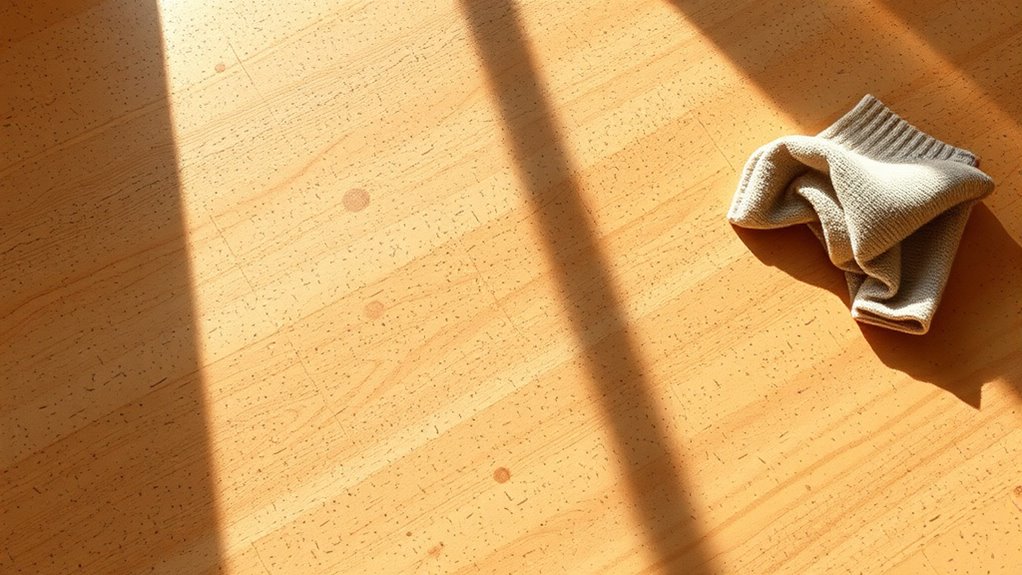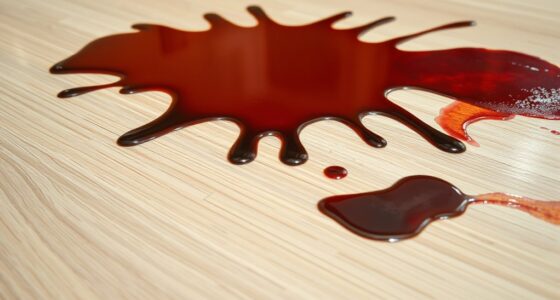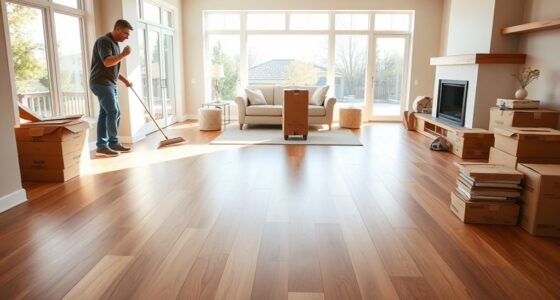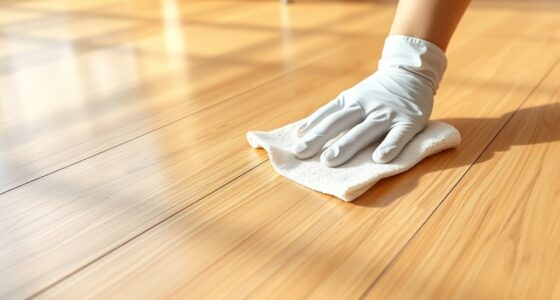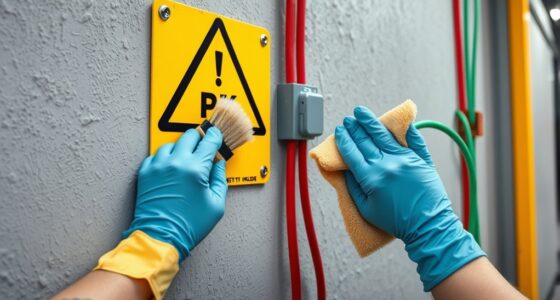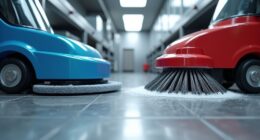Before you mop, start by removing dirt, dust, and debris with a soft broom or vacuum using a brush attachment—avoid anything with beater bars that can scratch the surface. Next, use a damp, not soaking wet, pH-neutral cleaner specifically designed for cork floors, and wring out your mop thoroughly. Applying these steps guarantees your floor stays protected from scratches and damage. Keep going to discover more expert tips for maintaining your cork floors in top condition.
Key Takeaways
- Sweep or vacuum with a soft brush attachment to remove dirt and debris before mopping.
- Place felt pads under furniture legs to prevent scratches during cleaning.
- Use a damp, not soaking, pH-neutral mop to avoid water damage and surface wear.
- Lift furniture instead of dragging it across the floor before mopping.
- Remove shoes with rough soles and trim pet nails to reduce scratching risk during cleaning.
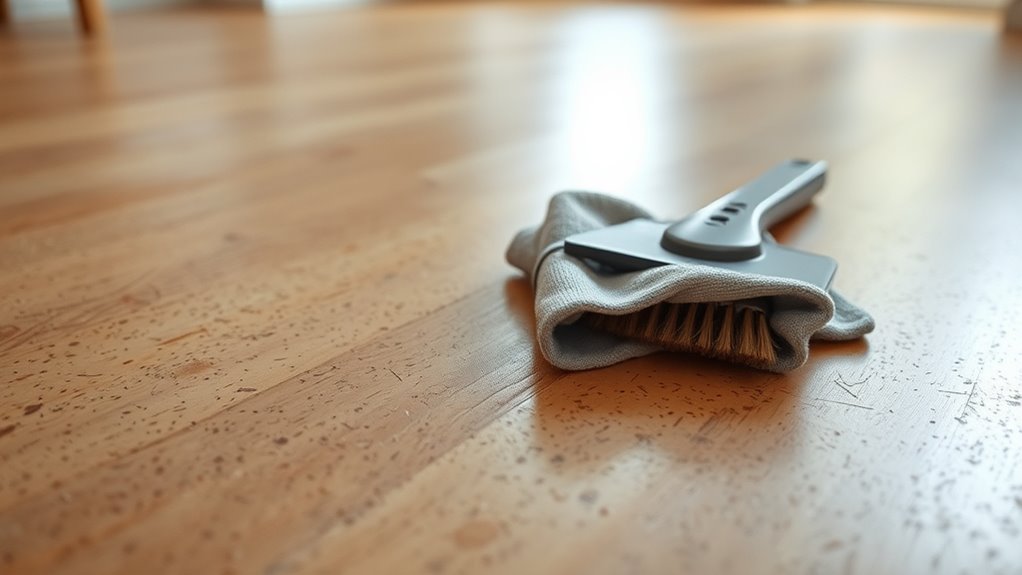
Cork floors are a stylish and eco-friendly choice for many homes, but scratches can quickly mar their natural beauty. Before you reach for your mop, it’s essential to understand how to protect your cork flooring from damage and keep it looking its best. Proper cleaning techniques and protective measures are key to preventing scratches and maintaining the floor’s integrity over time.
First, focus on the cleaning techniques you use. Dirt, dust, and debris are the main culprits behind scratches. Regularly sweeping or vacuuming with a soft brush attachment removes these particles before they can scratch the surface when you walk or move furniture. Avoid using a vacuum with a beater bar, as its rotating brush can scratch cork flooring. When mopping, choose a damp mop rather than soaking the floor with excess water. Use a gentle, pH-neutral cleaner specifically formulated for cork or hardwood floors. Harsh chemicals or abrasive scrubbers can weaken the surface finish, making your cork more vulnerable to scratches. Always wring out your mop thoroughly so it’s just damp, never soaking, and wipe in the direction of the grain to prevent streaks and uneven wear.
Protective measures are equally important. Place felt pads or furniture coasters under heavy furniture legs to prevent scratches when you move pieces around. Regularly check and replace these pads as they wear down. Rugs and mats can also act as shields at high-traffic areas, preventing dirt and grit from grinding into the cork surface. When walking with high heels or shoes with rough soles, consider removing them inside your home or switching to softer footwear. Keep pet nails trimmed to avoid scratches caused by claws, which can be sharp and damaging over time. Additionally, avoid dragging heavy objects across the floor; instead, lift and carry them to prevent gouges.
Frequently Asked Questions
Can Cork Floors Be Sanded to Remove Scratches?
Yes, cork floors can be sanded to remove scratches, but you should use gentle sanding techniques to prevent damage. Start with fine-grit sandpaper and lightly sand the affected area. For deep scratches or extensive damage, consider professional repairs to ensure a smooth finish. Remember, cork is softer than hardwood, so proceed carefully and avoid over-sanding, which can compromise the floor’s integrity.
Are There Specific Cleaning Products for Scratched Cork Floors?
Don’t put all your eggs in one basket with cleaning products. For scratched cork floors, look for gentle, pH-neutral mop solutions designed specifically for cork or hardwood. These products help preserve the finish without causing more damage. Stick to a consistent cleaning routine, avoiding harsh chemicals or abrasive scrubbing, to keep your floors looking their best and prevent further scratches. A careful approach will save you time and money down the road.
How Long Does It Take for Scratches to Become Deep?
Scratches on cork floors can deepen within days or weeks if you don’t follow proper maintenance routines. Surface treatments like sealants can slow this process, but heavy foot traffic, pet claws, or debris cause scratches to become deep more quickly. Regular cleaning and applying protective surface treatments help maintain your floor’s integrity, preventing scratches from worsening. Stay proactive with maintenance routines to keep your cork floors looking their best longer.
Is Waxing Effective for Repairing Scratches on Cork Floors?
Waxing can be like a quick bandage for your cork floors, but it mainly offers concealment rather than real repair. Its effectiveness depends on the scratch’s depth—shallow scratches may be temporarily masked, yet deep ones need more thorough fixes. Think of waxing as a temporary cloak; it hides surface imperfections but doesn’t truly mend the damage. For lasting results, consider proper repair methods over just waxing for scratches.
Can Furniture Pads Prevent Future Scratches on Cork Floors?
Yes, furniture pads can prevent future scratches on cork floors. By using furniture protection, you distribute weight evenly and reduce direct contact, minimizing damage. Incorporate pads into your floor maintenance routine to keep your cork floors looking pristine. Regularly checking and replacing worn pads guarantees continued protection. This simple step helps maintain your floors’ beauty and longevity, saving you time and money on repairs and refinishing.
Conclusion
To keep your cork floors beautiful, act quickly, prevent scratches, and protect your investment. Address scratches promptly, prevent them with felt pads, and maintain your floors regularly. By doing these, you preserve their charm, extend their life, and enjoy their warmth—every step, every glance, every moment. Remember, your care makes the difference. Take action today, protect your cork floors, and let their natural beauty shine through for years to come.
